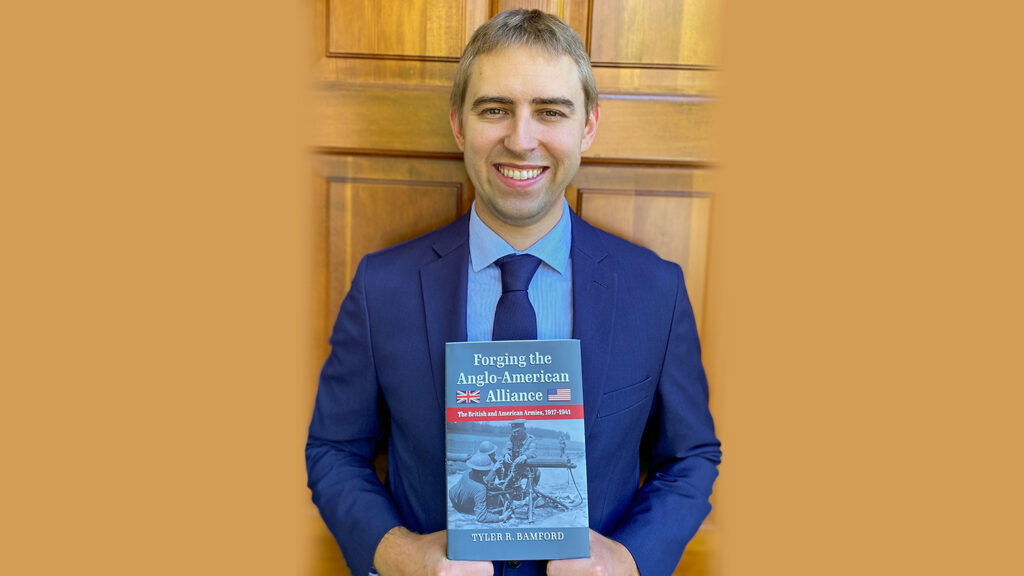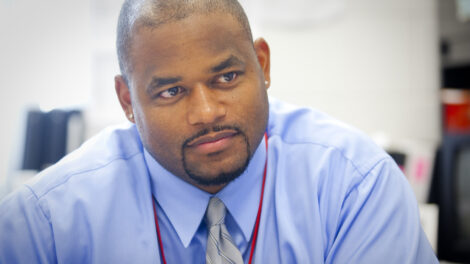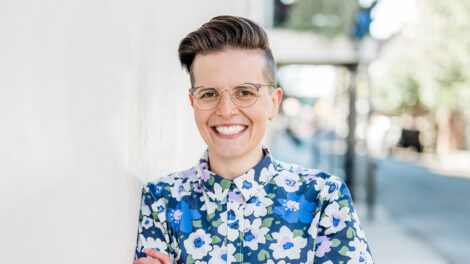Navy historian Tyler Bamford ’12 publishes first book
By Bryan Hay
When Tyler Bamford ’12 came to Lafayette College, he knew he wanted to be a history major, his sights set on becoming a high school history teacher.
But that career path changed as his professors, including Rebekah Pite, professor of history and department head, and Donald Miller, John Henry MacCracken Emeritus Professor of History, recognized his latent gift for scholarship and research.
“I chose Lafayette specifically because I knew I wanted to study history,” says Bamford, who always had an interest in World War II and earned his Ph.D. in American and European history from Temple University. “Lafayette history faculty trained me in the nuts and bolts of how history is done. I didn’t know that a career as a history scholar was something I wanted to do until I saw what my professors did. And I said, this looks like a fascinating job. How do you do this?”

Navy historian Tyler Bamford ’12
Ask Bamford now about where his career has taken him, and he’ll tell you he has the best job in the world, at least for a military historian.
He joined the Naval History and Heritage Command in Washington, D.C., as a historian last year and recently published his first book, Forging the Anglo-American Alliance: The British and American Armies, 1917-1941, with the University Press of Kansas, a project that took him 10 years to complete.
Based in the historic Washington Navy Yard, the Navy’s oldest shore installation, the Naval History and Heritage Command (NHHC) reports directly to the Chief of Naval Operations and includes all of the Navy’s museums, including museum ships such as the USS Constitution, and its library and archive. Civilian government employees comprise the NHHC staff.
Bamford’s work for NHHC includes writing articles and books about the Navy’s history, supporting the Navy’s sailors by giving presentations, delivering talks to public audiences, supporting Navy commemorations, answering official inquiries, consulting on Navy Museum exhibits and developing new ones, giving tours of the Navy Yard, and answering inquiries from members of Congress and the general public.
“My biggest responsibility for the Navy now is researching and writing about the history of the Navy,” he says with enthusiasm. “I love going into the archive or going into the library, finding books that haven’t been checked out in five decades or longer, and reading things and being like, wow, I never knew this. This is incredible. And I just want to share it with everybody.
“I get to uncover this stuff, I get to write about it, and then publish it, which is amazing,” Bamford says. “It’s like I’m getting paid to be a professional student, which is phenomenal. I love getting to read all day. I regularly think, man, I can’t believe this is my job.”
He’s among a vast community of scholars who research history for the U.S. military. In fact, he’d encourage current Lafayette history majors to consider a career as a government historian.
“The U.S. government actually employs more Ph.D.s than any other employer. I would encourage anyone studying history, especially in the military history field, to think about a career in this area,” Bamford says.
“The Army has its official historians, as does the Navy, the Marine Corps, and the Air Force, and then you’ve got all the people teaching at all of the military academies and military schools,” he says. “There’s a lot of work for us through the federal government.”
His interest in the period between World War I and World War II, which inspired his book, began at Lafayette when he worked on his undergraduate thesis with history Prof. Paul Barclay.
“I found out that not much had been written about the United States and Great Britain between the wars, yet their alliance was the closest military alliance that the world has ever seen between two sovereign nations,” Bamford says.
“The stability of our post-World War II world has really always hinged on the United States and its relationship with its allies,” he adds. “There’s been no greater, no more important ally to the United States in the last 80 years than Great Britain. There have been times when they haven’t been friends, but if you look at all the major crises, you’ll find that the United States and Great Britain oftentimes close ranks and find a lot in common. You still see that in the war in Ukraine.”
Read more about Bamford’s book.
Lafayette, making it all possible
“Lafayette, for me, was a transformative experience. It’s where I wanted to study history,” says Bamford, who’s working on books about souvenirs GIs brought home from World War II and wartime letters between the U.S. Pacific Fleet commander Adm. Chester Nimitz and his wife.
“I’ve talked to other colleagues who’ve gone on to work at other institutions, and they say there’s really nothing compared to the undergraduate experience at Lafayette for that focus, that small classroom, that conversational learning,” he says. “I’ve been privileged to teach for a number of other institutions, all of them with phenomenal students. But I know that for me, personally, I couldn’t have ended up anywhere better than Lafayette.”

